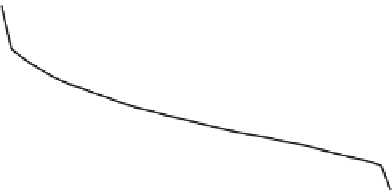Environmental Engineering Reference
In-Depth Information
TABLE 4.11. Load-Duration Data Derived from Measurements
Exceed (%)
Load (×10
10
CFU/d)
Load (×10
10
CFU/d)
Load (×10
10
CFU/d)
Exceed (%)
Exceed (%)
0.5
544
31.5
40.9
72.1
23.8
1.3
365
34.2
42.0
75.8
25.0
2.8
256
37.4
47.9
78.3
30.1
3.6
304
40.6
19.2
81.4
19.6
4.4
256
42.8
20.7
84.7
15.8
5.2
176
44.3
33.3
87.9
12.6
6.7
178
46.7
32.8
90.8
10.5
7.5
223
48.2
30.2
91.3
10.3
8.6
74.5
50.5
19.5
92.7
11.1
9.2
175
52.7
23.9
93.1
10.3
10.4
144
54.3
20.3
94.5
9.60
13.6
94.0
56.6
26.6
95.3
10.4
16.8
111
58.4
24.3
96.7
8.72
19.7
105
60.4
27.4
97.8
7.95
22.4
26.5
63.8
26.5
98.2
7.72
25.3
71.2
66.7
21.5
99.1
6.69
28.9
52.3
69.2
34.2
-
-
concept here is that within each flow condition, the same
representative flow rate can be assumed for both the
LDC and the measured loads (
Q
i
c
i
), and so exceedance
of the TMDL is primarily attributable to fluctuations in
contaminant concentrations in the stream. Conse-
quently, the required adjustment to the contaminant
load is the same as the required adjustment to the con-
taminant concentrations for the given flow condition.
The procedure for calculating the required load adjust-
ment for any given flow condition is as follows:
10
14
10
13
load duration curve
10
12
measurements
10
11
dry
conditions
Step 1.
Segregate the concentration measurements,
c
i
, into only those measurements taken under a
specified flow condition. Fit a standard probability
distribution to the observed concentrations. A log-
normal distribution with a mean and standard
deviation determined using
10
10
0
10
20
30
40
50
60
70
80
90 100
exceedance percentage (%)
Figure 4.19.
Comparison of measurements with TMDL.
the method of
moments is usually sufficient.
Step 2.
Specify the percentile value of the concentra-
tion distribution that is to be matched to the
water-quality standard, and then determine the
fractional reduction in concentrations for the mea-
sured concentration distribution to comply with
the water-quality standard.
∆ =
log
c
−
log
c
std
(4.167)
β
and applying this reduction to all the measured log con-
centrations will bring the instream concentrations into
compliance with the water-quality standard. Since
Equation (4.167) can be expressed in the form
This approach is illustrated in Figure 4.20 for the
case in which the measured concentrations have a log-
normal distribution with a mean of
µ
log
c
and a variance
of
σ
log
2
. If the water-quality standard,
c
std
, is associated
with the
β
-percentile of the instream concentration dis-
tribution, and the observed
β
-percentile concentration
is
c
β
, then the required reduction in the log-concentration,
Δ is given by
c
std
=
c
β
10
∆
−
(4.168)
then it is apparent that existing loadings within the
specified flow condition range will need to be reduced
by a factor of 10
−Δ
to bring the stream into compliance
with the water-quality standards under those particular
flow conditions. In general, the stream must be in








































Search WWH ::

Custom Search